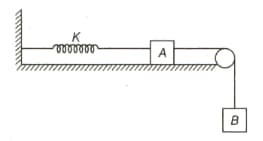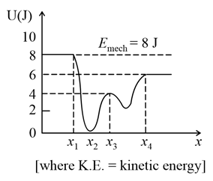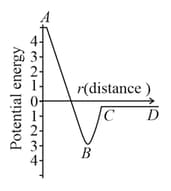When a long spring is stretched by 2 cm, its potential energy is U. If the spring is stretched by 10 cm, the potential energy stored in it will be
Important Questions on Work, Energy and Power
A particle is kept on the surface of a uniform sphere of mass and radius . The work done per unit mass against the gravitational force between them is
In the figure, mass of is and that of is . All the surface are smooth. System is released from rest with spring unstretched. Then, the maximum extension in spring will be

Two springs of force constants and are stretched by the same force. The ratio of potential energies stored in them is
Given below is the plot of a potential energy function for a system, in which a particle is in one dimensional motion, while a conservative force acts on it. Suppose that , the incorrect statement for this system is :

The graphs below show the magnitude of the force on a particle as it moves along the positive -axis from the origin to . The force is parallel to the -axis and conservative. The maximum magnitude has the same value for all graphs. Rank the situations according to the change in the potential energy associated with the force, least (or most negative) to greatest (or most positive).

The figure shows the variation of potential energy with distance. The part of the graph which represents the repulsive force is


